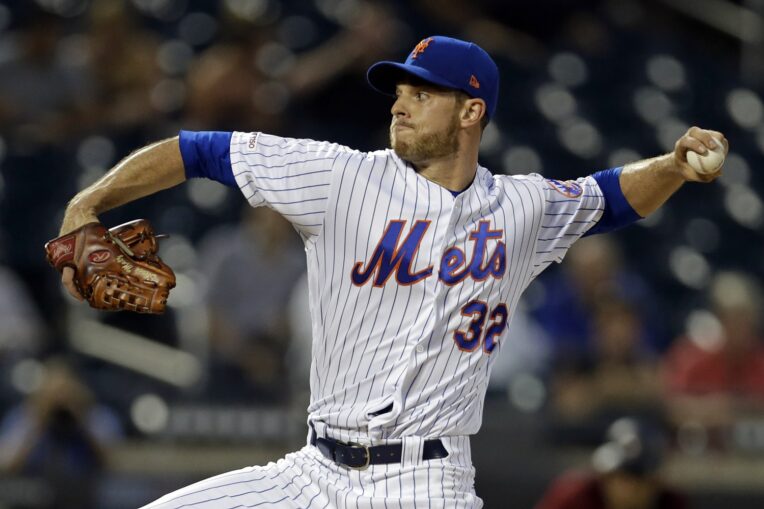
By Matt Musico
When looking at rotation fWAR, the New York Mets had the third-best starting staff in baseball this past year, finishing just behind the Los Angeles Dodgers. And with 941.1 total innings pitched, the rotation led the league in that particular category. Although Jacob deGrom, Noah Syndergaard, and Zack Wheeler once again accounted for the majority of the fWAR produced, left-hander Steven Matz made his presence felt at certain points throughout the season.
For the second consecutive year, the southpaw started at least 30 games, and his 160.1 innings pitched are a new single-season career high. His 22.1% strikeout rate and 7.5% walk rate are basically in line with what he accomplished in 2018, and while his 11-10 record with a 4.21 ERA and 1.34 WHIP don’t jump off the page, the 1.6 fWAR he finished with is more than what he produced in the previous two years combined (1.2 fWAR in 220.2 innings).
There were some concerning trends that continued for Matz in 2019, but there were some other aspects of his performance that show a bit of growth heading toward 2020.
The Concerning Stuff
Something that’s been an issue for Matz over the last three seasons is the home-run ball. Although his 1.52 homers allowed per nine innings didn’t finish much higher than the league’s average of 1.44, there’s been a clear shift for the southpaw when looking at how this category has changed throughout his young career. Between 2015 and 2016, Matz prevented that number from going higher than 1.01, but has failed to get it below 1.46 in any of the three years that have followed.
The 27 dingers he gave up in 2019 were not only a career-worst mark, but it was also among the higher totals in the game. While we’ll get to the good stuff shortly, it’s worth noting that Matz got this under control following the All-Star break. He entered the midsummer respite with a homers allowed per nine innings rate of 2.00, a number that dropped down to 1.02 in the second half. That was made possible by a five-percentage-point drop in fly-ball rate and approximately a seven-percentage-point drop in hard-hit rate allowed when splitting his season in half.
Another trend that’s mostly continued throughout Matz’s career is the discrepancy between his performance at home and on the road. Citi Field has mostly lended itself to being a pitcher-friendly venue for hurlers, which the lefty has typically taken advantage of over the years. However, the difference between his home ERA (2.31) and road ERA (6.62) is rather stark.
It doesn’t help that some of his worst starts from 2019 all came on the road (April 16th and June 24th at Philadelphia and September 16th at Colorado), which certainly inflates his ERA in this situation. This also comes with huge decreases in production for many areas of his profile, like strikeout rate (25.2% to 18.7%), WHIP (1.15 to 1.58), strand rate (84.9% to 64.8%), and homers allowed per nine innings (0.80 to 2.42), among other things.
The Not-So-Concerning Stuff
For someone like Matz, who had failed to consistently rack up big-league innings in the past because of injuries, it’s important to see how he handles that kind of workload throughout any given season. When he surpassed the 150-inning mark in 2018 for the first time, he mostly appeared to struggle before finishing strong in September (3.38 first-half ERA, 4.97 second-half ERA). Fast-forwarding to 2019, though, it was the opposite — the 28-year-old appeared to get stronger as the year dragged on when looking at how his first-half ERA (4.89) and second-half ERA (3.52) compare.
However, outside of a couple tough months, Matz was pretty consistent from a run prevention standpoint for the Mets. From March/April to September, his monthly ERA totals looked like this: 3.68, 3.38, 7.36, 1.80, 3.21, 5.06.
And while his first-pitch strike rate basically remained the same (56.6% to 56.4%), his zone percentage went from 49.0% to a career-low 45.0%. A noticeable shift in pitch mix accompanied this trend, as Matz’s fastball usage dropped nearly 10 percentage points, with substantial increases to his slider (8.4% to 14.4%) and changeup (15.9% to 20.1%) usage. The only problem here is that for those two pitches, opposing hitters produced a 120 and 121 wRC+, respectively, against them.
Looking Ahead
There were some good things and some bad things that came out of Steven Matz’s 2019 season, virtually making it the definition of a mixed bag. The southpaw came up with a ton of promise — especially after twirling a 2.27 ERA in 35.2 innings as a rookie in 2015 — but his performance since then has pretty much cemented his role as a back-of-the-rotation type of pitcher. And that isn’t a terrible thing since all big-league clubs need those kinds of pitchers for, well, the back of the rotation.
This upcoming season will be his age-29 campaign, a year in which he’ll be eligible for arbitration a second time. Free agency is still a ways off in 2022, but it’s coming fast for the hurler, so it’ll be important to him from a personal standpoint to continue getting stronger and more consistent. From a team perspective, it’ll be crucial for him to do continue doing the same thing because of changes the rotation will be going through. DeGrom isn’t going anywhere, but Wheeler may not be back, Marcus Stroman is set to hit free agency following next season, and even though Brodie Van Wagenen has already said Syndergaard won’t be traded this winter, we all know that could change quickly.
All things considered, Matz took a small step forward in 2019, and let’s hope the positive momentum he created during the second half can snowball into 2020.















